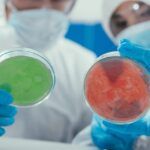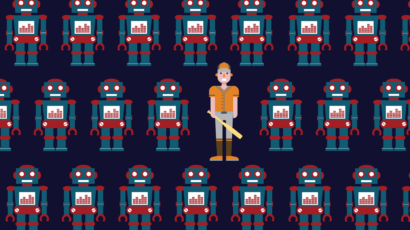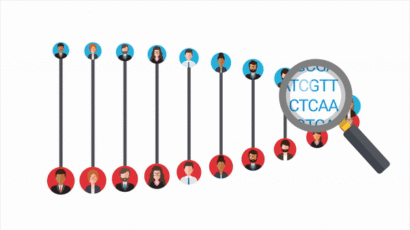Tracking the spread of biological technologies
By Robert Carlson | November 21, 2008
It is often said that the coming century will be dominated by biological technologies. For that to be true, our ability to design and build synthetic biological systems will require substantial improvement. Most products resulting from genetic modification on the market today are a consequence of a mere handful of changes in genetic structure.
Despite the very early stage of development of biological technologies, their economic impact is already substantial. In 2007, revenues resulting from the genetic modification of biological systems reached the equivalent of approximately 1 percent of the U.S. GDP.1 This total includes products under the moniker of biotechnology–drugs, crops, materials, industrial enzymes, and fuels–with revenues growing as much as 20 percent annually. The broader impact is less certain.
We generally assess the benefit or harm brought by a new technology through its uses and effects on our daily lives. What new capabilities does it bring? How much does it reduce energy consumption? How many lives can it save, or take? And finally, what are the costs? One could judge the pace and impact of biological technologies by many measures: health, nutrition, resource efficiency, social cohesion, economics, etc. One instructive metric is improvement in the ability to write genetic instructions, which allows one to home in on market pressures that may soon lead to an even greater proliferation of access.
Building genes from bits
Synthesizing genes reduces the labor, cost, and skill necessary to genetically modify biological systems. The vast majority of genes ordered today are synthesized using fairly standard technology. An ordered sequence of DNA is specified as electronic text and the subsequent chemistry is controlled by automation. Full-length, double-stranded genes are generally assembled from oligonucleotides (“oligos”), single-stranded DNA polymers. These oligos are themselves built one nucleotide at a time starting on a solid substrate (often porous glass beads), with less than 100 percent of all strands being correctly extended at each step. After 50 or 100 steps, a large fraction of oligos are thus truncated, missing at least one base in the ordered sequence. Subsequent use of these mixed-sequence oligos usually first requires purification of the polymers based on size; gene synthesis also requires proofreading of longer constructs via sequencing.
Two main uses create demand for synthetic DNA: large genetic constructs and short oligos that can be put to many uses, including assembling genes. Both market segments are facilitated by the tools of modern commerce; seqeuences are specified by the customer via e-mail and delivered via express mail by the producer. Instruments that produce oligos can be procured from many manufacturers, while genes are presently provided by centralized foundries that use proprietary assembly techniques and instrumentation.
The productivity of DNA synthesis instruments continues to improve exponentially, as does the productivity of gene sequencing instruments. The cost of both activities is also falling by a factor of two approximately every 20 months. Improved automation reduces labor requirements, raising productivity, and improved plumbing and measurement techniques independently reduce reagent costs and raise yields. Thus reading and writing DNA is becoming ever easier and more accessible.
The efficiency and intrinsic cost of gene assembly protocols vary, but because the price for genes is dropping faster than the price for the constituent oligos, the profit margin on those genes is also falling exponentially. While gene synthesis companies generally synthesize their own oligos, and thus face lower costs for those components, it is unclear how long a centralized industry can be supported by exponentially falling margins.
How have other industries fared in this sort of environment? Competition in the computer chip fabrication market has produced one large supplier, Intel, with most of the remaining market share supplied by AMD. This phenomenon is due at least in part to the enormous barrier to entry inherent in the cost of building a chip manufacturing plant–about $2.5 billion. Gene synthesis providers are racing along productivity, pricing, and margin curves very similar to those in the computer chip industry, with the added fundamental dynamic that the cost barriers to enter the competition are falling exponentially. This suggests that gene foundries may soon face competition from widely distributed automated instrumentation.
Gene assembly protocols generally require very high quality oligos, which makes the cost of genes a strong function of the cost of oligos. A new protocol presented at the recent Synthetic Biology 4.0 meeting in Hong Kong appears to enable the use of the lower quality oligos synthesized on arrays.2 This is but one such advance announced in the last few years. Other substantial efforts aim to miniaturize gene assembly instrumentation through microfluidic implementations of more traditional oligo production techniques. Costs will eventually fall even further as a result.
While it is relatively straightforward to sketch out a methodology that would enable on-chip production, purification, and assembly of oligos into genes, the practical implementation of these methods has thus far proven challenging. Nonetheless, the combination of biological, algorithmic, and micromechanical innovations necessary to build a desktop gene printer appear to be converging. I would expect to see the effective miniaturization of these capabilities within the next five years, leading to the even broader spread of these technologies.
This wouldn’t be the first time that the availability of design software and the miniaturization of production technology lead to their sudden proliferation. The emergence of personal computers with word processing and layout software–coupled with the appearance of desktop printers–transformed the printing and publishing industries. “Printing” genes and genomes would appear to be an even more powerful technology, and its broadening distribution is prompting calls for regulation.
Regulation has unexpected consequences
The potential application of gene synthesis to building pathogens causes profound discomfort. Yet it is not a simple task to determine what we should do about this potential threat. Some interested parties promulgate the idea of self-regulation focused on implementing standards for screening synthesis orders against genetic databases. This process might help identify genes that can be used to create pathogens or toxins. Not everyone, though, is convinced these actions would be sufficient. A recent Nature editorial called for “independent oversight” by governments of synthetic biology companies: “Regulators need to act.” However, history suggests implementing proscription can be an injudicious remedy.
In addition to the falling costs of biological technologies, the requisite training for using these technologies is gradually lessening. The fundamental skills are no more sophisticated than those many students learn in basic laboratory classes, and basic manipulations rely on widely available chemicals. As the widespread illicit distillation of alcohol during Prohibition and the proliferation of modern illegal drug synthesis labs illustrate, outlawing chemical products typically leads to black markets, which are more difficult to observe and to regulate than open markets.
This experience serves as a useful reference point for similar efforts to regulate biological technologies. The knowledge of chemistry required to produce illicit drugs, such as methamphetamine (meth), is not significantly less complex than what is required to synthesize DNA or genetically manipulate organisms. Due primarily to domestic restrictions on precursor chemicals and vigorous law enforcement efforts, the number of meth labs in the United States has dropped considerably since 2000 and meth-related sentencing has climbed dramatically, while the amount of meth seized by the Drug Enforcement Agency has fluctuated around 1,700 kilograms since 2000. Despite the large number of seizures, U.S. meth consumption continues to increase, due to increases in the amount of meth supplied from abroad.
Regulation is therefore causing a shift from distributed, domestic production to foreign centralized operations, many of which have ties to organized crime. Increased enforcement efforts are paradoxically producing an infrastructure that is, according to the DEA, “More difficult for local law enforcement agencies to identify, investigate, and dismantle because [it is] typically much more organized and experienced than local independent producers and distributors.” The resulting concentration of capability and capital has enabled such organizations to embark on sophisticated independent technology development programs that innovate in the areas of drug production, financing, and distribution. Beyond the simple physical difficulty of enforcing laws against drug production and distribution under these circumstances, these producers have a strong economic incentive to evade such regulation.
The underlying issue with methamphetamines production is that some people are willing to pay for, and others to produce, an illegal and dangerous product of a distributed technology despite harsh consequences for both users and producers. This phenomenon is likely to play a role in markets for the products of biological technologies.
Whither biosecurity policy?
Managing technological innovation is complicated, particularly when large amounts of money are involved, and attempts at regulation have met with varying degrees of success. Regulation in the form of legislated oversight and limited debt-to-capital ratios played an important role in stabilizing the financial sector after the Great Depression, while enforcement of equipment and crashworthiness standards served to improve the safety of automobiles from the 1960s onwards. These industries rely on relatively centralized production infrastructure, and their successes and failures are relatively easy to track. Regulation in the form of proscribed access to raw materials and proscribed possession and trafficking of products has had less success, and has even been judged counterproductive, in regards to alcohol, drugs, internet cracking, and software piracy. These industries are characterized by a low economic barrier to entry, by a widely distributed production infrastructure, and by skill sets that can be acquired in secondary school.
To which of these classes of industries is biological technology most similar? The answer might aid in determining the course of policy. For inspiration, one might look to the recently completed 2008 International Genetically Engineered Machines (iGEM) competition at MIT. Undergraduates and high school students from around the world presented new vaccines, probiotics, biosensors, and bioenergy production systems, all built over the course of a summer. While all iGEM teams had access to excellent facilities and mentoring, most of their projects could have been pulled off in a garage lab equipped from eBay and a hardware store. Protocols for all the requisite genetic hacking are available on the web, and the only limitations to accessing new skills are practice and patience. Thus my own conclusion, based on exponential increases in productivity, exponential reductions in cost, and the global proliferation of cutting edge research into developing countries, is that imprudent regulation of biological technologies could create more problems than it solves.
The counterargument typically relies on inspiring fear and encouraging proactivity. We cannot wait for perfect policy to implement security measures, the thinking goes. Yet this argument obscures the investigation and debate that must come first: Is it at all possible to slow down the actions of potential aggressors? Will regulation increase knowledge of threats or further obscure them? Finally, will these efforts, whether successful or not, also retard crucial research required to produce countermeasures for both natural and artificial threats?
Most proponents of regulation have not addressed these questions. Greater knowledge of potential threats is clearly desirable. Reducing the threat from bioerror and bioterror is an even more important goal. Formulating effective policy requires acknowledging the pace and proliferation of biological technologies as well as carefully weighing any potential negative impacts of action.
1Rob Carlson, “Laying the Foundations for a Bio-economy,” Systems and Synthetic Biology, vol. 1, no. 3, 2007, p. 109-117.
2Alex Borokov, poster paper, “SynBuild, An Accurate High-Throughput Gene Assembly Platform that Uses Microarray Synthesized Oligos,” Synthetic Biology 4.0, October 2008, Hong Kong.
Together, we make the world safer.
The Bulletin elevates expert voices above the noise. But as an independent nonprofit organization, our operations depend on the support of readers like you. Help us continue to deliver quality journalism that holds leaders accountable. Your support of our work at any level is important. In return, we promise our coverage will be understandable, influential, vigilant, solution-oriented, and fair-minded. Together we can make a difference.
Topics: Biosecurity, Opinion














